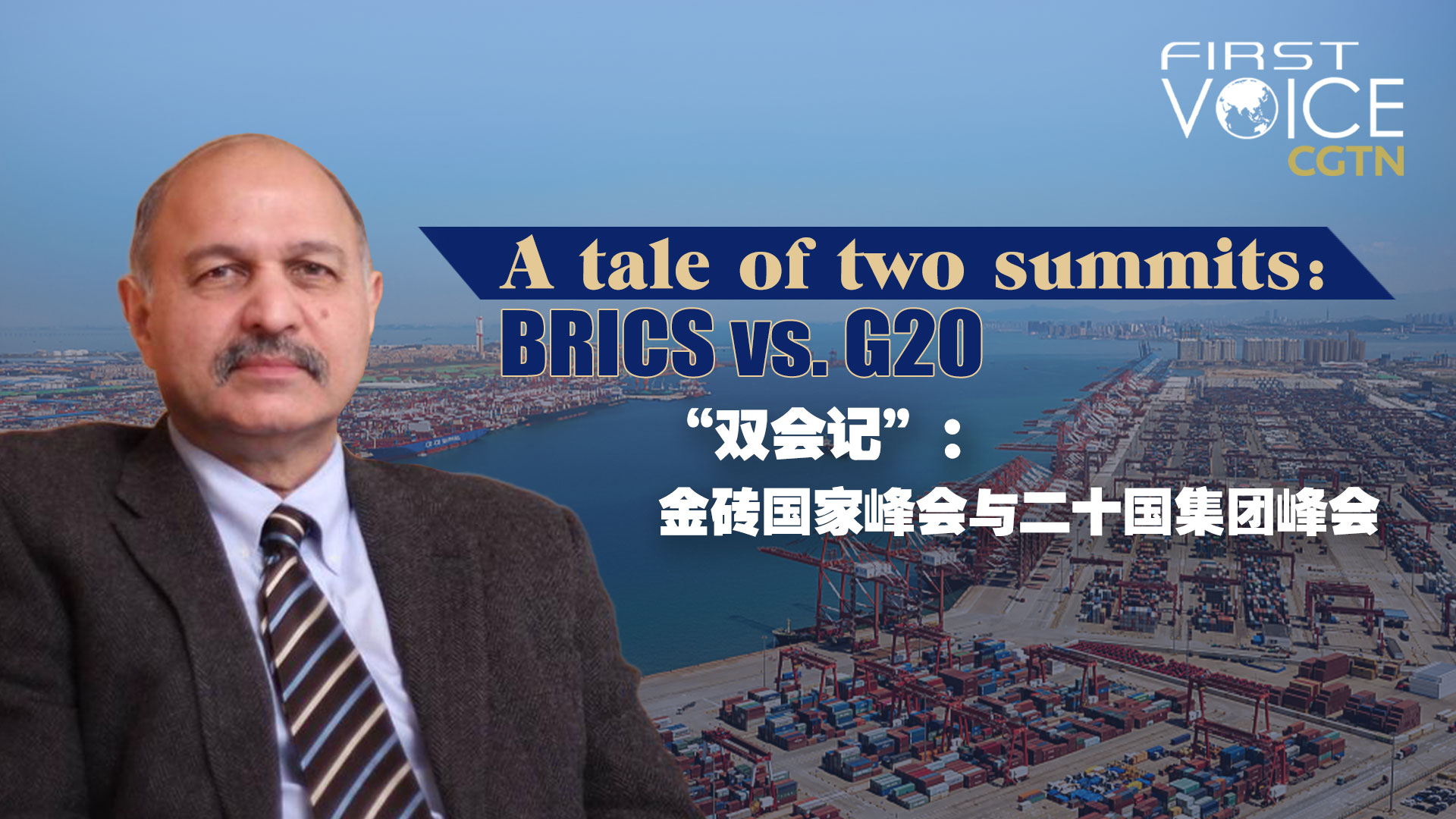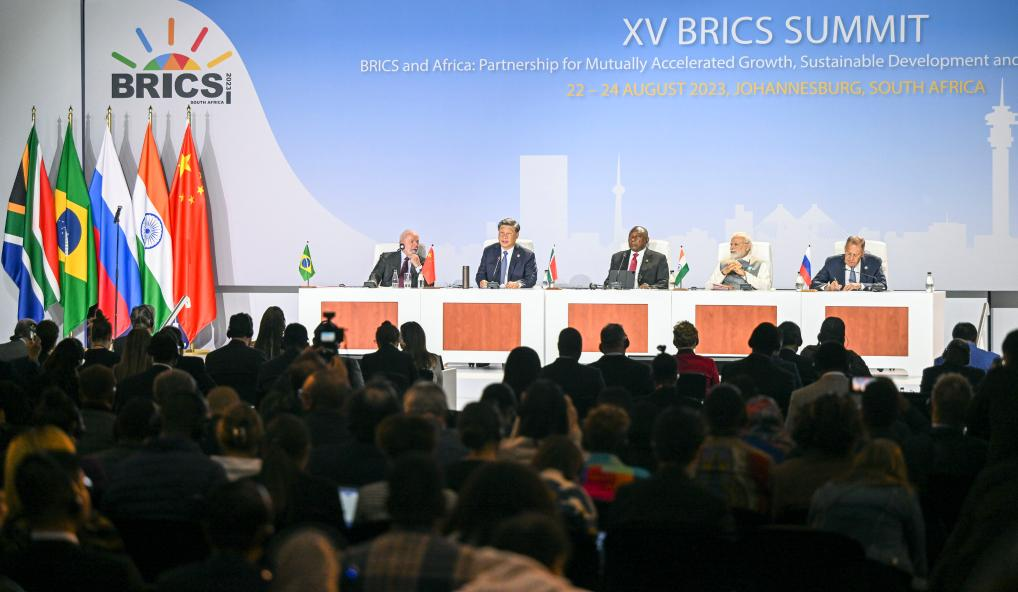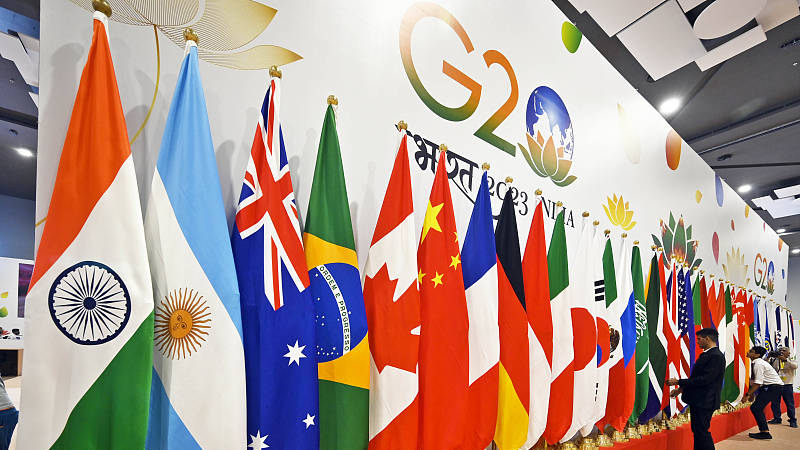
Editor's note: CGTN's First Voice provides instant commentary on breaking stories. The column clarifies emerging issues and better defines the news agenda, offering a Chinese perspective on the latest global events. Mushahid Hussain is Chairman of the Senate Defence Committee of Pakistan. The article reflects the author's opinions, and not necessarily the views of CGTN.
Reflecting a polarized world, two major summits within three weeks, with some overlap in membership presented a marked contrast in goals and outcomes. The BRICS Summit (which is an acronym of the current members Brazil, Russia, India, China and South Africa) hosted by South Africa, and the G20 Summit held in India, in August and September respectively, are polarizing examples.
The BRICS Summit in the land of Mandela reflected the late leader's ethos of pluralism and inclusivity, while the G20 Summit in the land of Modi saw the conspicuous absence of Chinese President Xi Jinping, who had been the star of the show at Johannesburg. President Putin was absent from both, while President Biden and other Western leaders were in attendance in a spruced-up New Delhi.
However, both summits were dominated by the "China factor": BRICS, which had substance, was essentially showcasing Chinese diplomacy at its best, because after Beijing brokered the historic Iran-Saudi Arabia rapprochement in March 2023, at BRICS, both Middle Eastern powers together with UAE, Ethiopia, Egypt and Argentina, were welcomed into what is now the BRICS+, putting the largest producers and consumers of oil on one table.
At the G20 Summit in Delhi, which was more about symbolism as a two-in-one attempt by Prime Minister Modi to make India the West's bridge to the Global South while choreographing the early launch of his election campaign through extensive billboards, photo ops and not-so-sophisticated PR. In fact, the most concrete outcome at the G20 was to unveil a copycat version of the China-led Belt and Road Initiative (BRI).
Despite deriding the BRI, the West pushed for the launch of the rather grandiose-sounding India-Middle East-Europe Economic Corridor (IMEC). Imitation, as the English saying goes, is the highest form of flattery! Unfortunately, Turkey, which would be integral to any Indian-European corridor, rained on IMEC's parade after President Erdogan declared his opposition. China and Russia's reservation also don't help IMEC's prospects.
Incidentally, this is the West's third attempt in three years to copy the BRI: In 2021, President Biden announced the B3W (Build Back Better World) which was later rebranded as the Partnership for Global Infrastructure and Investment (PGII), while the European Union, not to be left behind, announced its copycat version of the BRI, calling it "Global Gateway."
And what was touted as a "breakthrough achievement" at the G20 Summit, the "consensus" on Ukraine, was a rehash and reaffirmation of universal principles enshrined in the UN Charter and the Five Principles of Peaceful Coexistence. The real story was in the West's retreat on Ukraine from a position of outright condemnation of Russia to parroting India's verbose diplomatic jargon.
The fundamental difference between G20 and BRICS+ is that the G20 remains an extension of the G7 with strong geopolitical overtones, as largely a status quo platform, now influenced by a Cold War mindset, of which India, as a major American ally, is a key component. Conversely, BRICS+, spearheaded by China, is clear on its geopolitical and geo-economic vision and will to play an active role in a world where the Global South is the pivot. Hence, deepening interaction in local currencies among BRICS states is on the agenda of the organization.

Chinese President Xi Jinping (2nd from left) delivers an important speech at a press conference during the 15th BRICS Summit in Johannesburg, South Africa, August 24, 2023. /Xinhua
Chinese President Xi Jinping (2nd from left) delivers an important speech at a press conference during the 15th BRICS Summit in Johannesburg, South Africa, August 24, 2023. /Xinhua
The future of BRICS+ and G20 will also be determined by their respective goals, stated or unstated, and their contrasting visions. China, as a country with an illustrious civilizational heritage, has been the harbinger of globalization for the past 2,000 years when the Silk Road used to connect China with Central Asia, the Middle East and Europe through commerce and culture.
As the modern-day version of the Silk Road, the ten years old BRI comprises more than 150 countries and over 30 international organizations, with more than 3,000 projects, generating more than 420,000 jobs and lifting almost 40 million people out of poverty. Out of 193 countries that are members of the United Nations, more than 120 countries have more trade with China than with the United States, from the Solomon Islands to Saudi Arabia. Underpinning the BRI and BRICS+ for that matter, are institutions like the Asian Infrastructure Investment Bank (AIIB) and the New Development Bank, respectively.
The BRI has been reinforced by the Global Development Initiative (GDI), Global Security Initiative (GSI) and Global Civilization Initiative (GCI), which all promote equality, inclusivity and diversity through connectivity and cooperation.
China is focusing on modernization, especially on cutting-edge 21st century technologies, including 5G, Artificial Intelligence, robotics, and cloud computing. According to a landmark study by Harvard University, "The Great Tech Rivalry: China vs. the U.S.," it is pointed out that China "has displaced the U.S. as the world's top high-tech manufacturer," evident in the recent launch of the Huawei Mate 60 Pro smartphone, which has managed to beat the American sanctions by producing an advanced, sophisticated, state-of-the-art product.
Conversely, the past two U.S. administrations have been busy weaponizing international relations, increasing their military budgets, building military bases (by the Pentagon's own count, 313 U.S. military base sites in East Asia alone), arming Asian allies against China and building a network of military alliances including an "Asian NATO," while NATO itself now hypes up the "China threat."
No wonder, CNN referred to the fact that "China is nothing short of a foreign policy fixation in Washington," although Fareed Zakaria gave the correct prognosis that "the rest of the world doesn't see China as we do." One reason for this yawning chasm between the West and the rest of the world on China policy is, as the former senior American administration official, Fiona Hill, aptly commented, "In the so-called 'Global South' … The Perception of American hubris and hypocrisy is widespread" in the conduct of its foreign policy.
The American "fixation" with China can even be viewed as borderline racist. In May 2019, Kiron Skinner, former Director of Policy Planning at the United States Department of State, openly described the conflict with China as a "fight with a different civilization," even providing a racial context to the emerging U.S.-China competition, saying, "it's the first time that we will have a great power competitor that is not Caucasian."
China's leadership role in the Global South has also been enhanced by its proactive diplomacy in building bridges as Beijing successfully became an honest broker between Iran and Saudi Arabia, subduing a long-standing rivalry that was destabilizing much of the Middle East for the past three decades.

A volunteer arranges the participating countries' flags at International Media Centre near the Bharat Mandapam in New Delhi, India, September 8, 2023. /CFP
A volunteer arranges the participating countries' flags at International Media Centre near the Bharat Mandapam in New Delhi, India, September 8, 2023. /CFP
48 years after G7's establishment in 1975 and 24 years after the launch of its offshoot, G20, in 1999, and 10 years after the BRI was announced in 2013, their respective worldviews, policies and approaches are rooted in their different strategic cultures, based on their historical evolution, and analyses of these are necessary for understanding these divergences.
2023 marks a year of anniversaries for both China and the United States, reflecting this contrast in perspectives and policies. For China, which has an economic-centric approach, it marks 10 years of the BRI, probably the most important developmental and diplomatic initiative of the 21st century. For the United States, 2023 marks three anniversaries reflecting the U.S. security-centric worldview: 70 years since the CIA coup in Iran, 50 years since the CIA coup in Chile and 20 years since the war in Iraq began. Their respective strategic culture reflects this contrast.
Key components of China's strategic culture include: the Silk Road, connectivity and cooperation amongst countries, cultures and civilizations; the Great Wall, which conveys China's defensive and protective approach against outside intruders and aggressors; the Long March, a long and costly struggle critical to the survival of Communist Party of China (CPC), demonstrating patience, perseverance and persistence, and a "Never Give Up" spirit; the "Century of Humiliation" from 1840-1949, a determination of "Never Again," never tolerating the violations of China's unity, sovereignty, territorial integrity and dignity. China's march to modernization takes its inspiration from its strategic culture.
Hence, it is not a surprise that China is the only global power in history to rise peacefully without any invasion, conquest, colonization or aggression. Earlier this year, in March 2023, President Xi Jinping announced the Global Civilization Initiative (GCI), stressing the importance of dialogue, harmony and respect among civilizations, as opposed to the racialized self-fulfilling prophecy "Clash of Civilizations," peddled by Harvard University Professor Samuel Huntington 30 years ago.
On the contrary, the American strategic culture has key ingredients reflected in the U.S. actions and worldview in the present-day. These include: the obsession with Pax Americana, since the days of the Monroe Doctrine, a desire to dominate; a glorified self-image of "American Exceptionalism," a "We are unique," expression of moral superiority over others, a modern day post-colonial version of the "White Man's Burden," an international do-gooder that invades and occupies countries or brings "regime change" for the greater good of countries at the receiving end; a trigger-happy combination of "Might is Right" and "Shock and Awe" perspective in foreign affairs as akin to the John Wayne-style diplomacy, which grants a shoots first, asks questions later approach; a powerful military-industrial-complex, a permanent war machine which needs constant refueling through bulging military budgets and an unending quest for a "bogeyman."
For the foreseeable future, as the Summits underline, China embarks on presenting a strategic option for the Global South (similar to what President Charles de Gaulle was presenting to Europe at the height of the Cold War) by building an alternative, more equitable world economic and political order, reflecting the shift in the global center of gravity from the West to the East. Western leaders too have hinted about this transformation. German Chancellor Olaf Scholz talked about "an epochal tectonic change" or "Zeitenwende," referring to a rapidly transforming global scenario. French President, Emmanuel Macron, was even more blunt, telling French diplomats that "I must admit that Western hegemony may be coming to an end."
(If you want to contribute and have specific expertise, please contact us at opinions@cgtn.com. Follow @thouse_opinions on Twitter to discover the latest commentaries in the CGTN Opinion Section.)